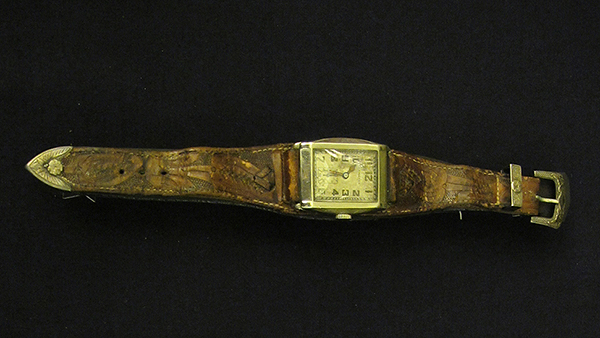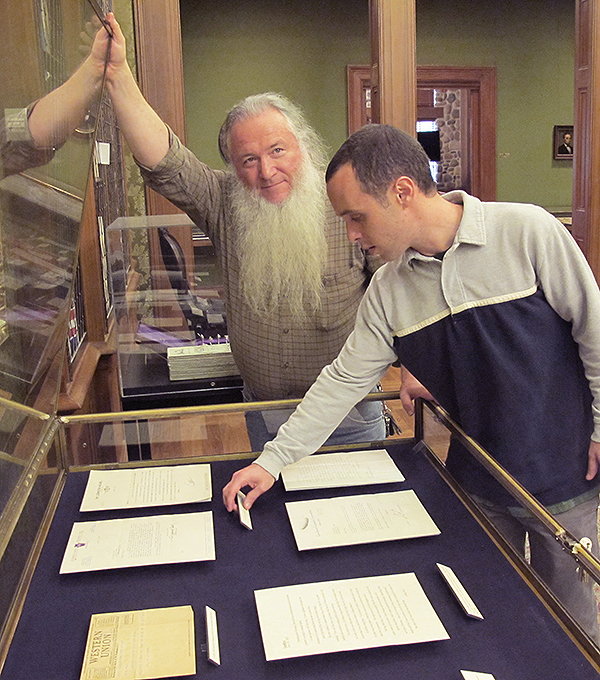Doctoral student’s exhibit focuses on Pyle’s aviation reporting days

In the Lincoln Room of the Lilly Library is a glass display case containing handwritten letters, a student pilot permit and a carefully preserved leather watch, a gift from Amelia Earhart.
Together, they represent a piece of one man’s career in journalism.
World War II correspondent Ernie Pyle is famous for his Pulitzer Prize-winning columns that told the story of war through the experiences of soldiers. But for several years in the 1930s, Pyle was an aviation reporter.
That era intrigued journalism doctoral student Nate Floyd, who curated the exhibit on display this week at IU’s Lilly Library, which has several of Pyle’s effects among its collections. The exhibit coincides with the Oct. 17 inauguration of The Media School and dedication of a new sculpture of Ernie Pyle installed last week near Franklin Hall.
Floyd said the timing was perfect for his project. He also is pursuing a master’s degree in library science, and the exhibit is part of his coursework.
When he arrived in Bloomington last summer, Floyd didn’t know much about Pyle, but quickly learned about Pyle’s historical significance at IU and in Indiana. Floyd chose Ernie Pyle’s experiences with aviation for his project because many people aren’t aware of Pyle’s career before the war.

“He’s covering these people, friends, that are dying in these sort of tragic and unexpected ways,” Floyd said of the artifacts and correspondence he found at the Lilly. It was an exciting era to cover as a reporter, he said.
“The pilots that are flying in the late ’20s early ’30s are a part of a Wild West of aviation, so a lot of those guys were passing away. There are a few letters in here from readers consoling Pyle as he’s lost a friend in a plane crash.”
In 1928, the Washington Daily News named Pyle the country’s first aviation columnist. Pyle made dozens of pilot friends, including the legendary Amelia Earhart. Earhart famously was quoted as saying “Any aviator who didn’t know Pyle was a nobody.”
The leather-strapped watch she gave Pyle has been part of the collection in the Ernie Pyle Hall lounge, and Lilly Library curator Cherry Williams personally walked with it from Ernie Pyle to the Lilly. Pyle was wearing the watch when he was killed reporting in the Pacific in 1945.

The other items in the case are from the Lilly’s collection, including Pyle’s student pilot permit, a book of his aviation columns, and some letters from well wishers after he announced he would quit writing the column to take on an editing job at the newspaper.
“I felt like I got a sense of his personality through reading his letters,” Floyd said. “Some of those letters were handwritten. And I thought seeing his handwriting, the way he wrote particular letters…made him come alive.
“And just as a history nerd, it was great to hold and read the exact same letters that Pyle was reading in the 1930s,” Floyd admitted.
After completing his undergraduate education at Marshall University in Huntington, West Virginia, Floyd had no reservations about where he wanted to attend graduate school.

“IU was the best fit for me. I didn’t apply anywhere else,” he said. ”The Ph.D. program allowed me to take a lot of courses in outside departments, and that’s what I needed to do, given my interests.”
The project was a requirement for his manuscript class, and all 10 students in the class will see their work on display for one week.
Monday afternoon, Floyd and Jim Canary, head of conservation at the Lilly Library, assembled the collection.
Canary assists with all of the installations and preparation for these exhibits for the manuscript class, while Floyd selected the content and information for the display
“It’s great working with grad students. Every day, it’s something new that I haven’t seen,” Canary said. “I’ve been here over 30 years, and I still find items in a collection that I haven’t seen before.”
The Pyle collection’s roots go back to the 1970s, when journalism librarian Frances Wilhoit took an interest in Pyle memorabilia and documents. As IU Libraries’ curator of the Pyle collection, Wilhoit preserved and added to the collection, which, in the early 1990s, she arranged to be housed at the Lilly Library.
The historical exhibit will be on display through Friday afternoon.

